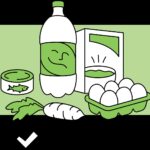Navigating airport security can be stressful, especially when you’re unsure about what you can bring on board. A common concern for travelers is whether they can take food on a plane. The good news is that, in most cases, the answer is yes! However, there are some rules and regulations you should be aware of to ensure a smooth journey.
General Food Items
The Transportation Security Administration (TSA) generally allows both solid and liquid food items in carry-on and checked baggage. However, there are some exceptions, particularly concerning liquids.
- Solid Foods: Most solid foods, such as sandwiches, snacks, fruits, and vegetables, are permitted in both carry-on and checked bags.
- Liquids: Liquid foods, such as soups, sauces, and yogurt, are subject to the 3-1-1 rule. This rule states that liquids must be in containers of 3.4 ounces (100 milliliters) or less, and all containers must fit into a single quart-sized, clear plastic bag.
Exceptions for Baby Food and Formula
There are special rules for baby food, breast milk, and formula. These items are considered medically necessary liquids and are exempt from the 3-1-1 rule.
- Quantities: You can bring formula, breast milk, toddler drinks, and baby/toddler food (including puree pouches) in quantities greater than 3.4 ounces or 100 milliliters in your carry-on baggage.
- Screening: Inform the TSA officer at the beginning of the screening process that you are carrying these items in excess of 3.4 ounces. Remove them from your carry-on bag to be screened separately from your other belongings.
- Testing: TSA officers may need to test the liquids for explosives or concealed prohibited items.
- Cooling Accessories: Breast milk and formula cooling accessories, such as ice packs, freezer packs, and gel packs, are also allowed, regardless of the presence of breast milk. If these items are partially frozen or slushy, they are subject to the same screening as described above.
Tips for a Smooth Screening Process
To expedite the screening process, consider the following tips:
- Transparency: Transport formula and breast milk in clear, translucent bottles rather than plastic bags or pouches. Liquids in plastic bags or pouches may not be able to be screened by Bottle Liquid Scanners, and you may be asked to open them for alternate screening.
- Inform TSA: Always inform the TSA officer that you are carrying medically necessary liquids at the beginning of the screening process.
- Separate Items: Remove these items from your carry-on bag to be screened separately.
Addressing Concerns about X-ray Machines
TSA X-ray machines do not adversely affect food or medicines. However, if you do not want your formula, breast milk, toddler drinks, or baby/toddler food to be X-rayed or opened, inform the TSA officer. Additional steps will be taken to clear the liquid, and you or the traveling guardian will undergo additional screening procedures, including Advanced Imaging Technology screening and enhanced screening of other carry-on property.
Special Accommodations and Assistance
Travelers requiring special accommodations or concerned about the security screening process at the airport may request assistance by contacting TSA Cares online or by phone.
Conclusion
In conclusion, you can take food on a plane, but it’s important to be aware of the TSA’s regulations regarding liquids and to follow the tips provided to ensure a smooth screening process. Be prepared to declare any medically necessary liquids, such as baby food and formula, and to have them screened separately. By understanding these guidelines, you can travel with your favorite snacks and essential food items without any unnecessary hassle.
